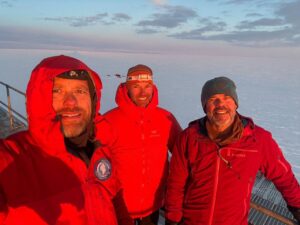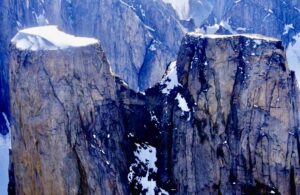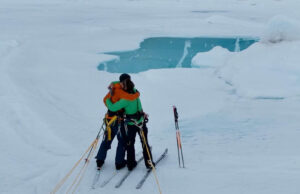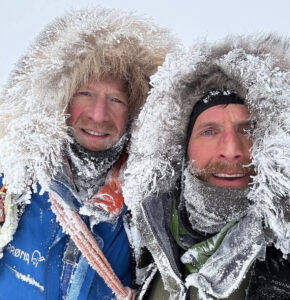Even Borge Ousland is apparently not immune from the ravages of COVID. When I spoke with him earlier this week, his Khumbu-type cough made almost every sentence he spoke staccato.
“It’s better than it was last week, though,” he said.
Nevertheless, recovering from COVID or not, the great arctic traveler had just returned from a 32-hour nonstop climb of the South Pillar of Stetinden, a classic multi-pitch Norwegian route. And later this week, he is flying to Canada to join Vincent Colliard to ski one of the more straightforward ice caps in their long-term Ice Legacy project.
Years ago, a researcher showed Ousland a list of the 20 biggest ice caps on earth. It struck him as a great long-term project: cross them all and draw attention to them and the threat of their disappearance. He partnered at the time with a young protegé, Vincent Colliard. Colliard, now 36, has done most of the ice caps with Ousland, as well as completed other projects of his own.

Borge Ousland, right, and Vincent Colliard. Photo: Borge Ousland
Nine ice caps so far
Ousland had already done Vatnajøkul (the largest ice cap in Iceland) and the Southern Patagonia ice cap. But the project began in earnest in 2014, when he and Colliard crossed the main Spitsbergen ice cap. They also did Svalbard’s Nordaustlandet. Since then, they’ve done roughly one a year — the Stikine in 2015, St. Elias in 2016, Alaska’s Chugach Icefield in 2017, and the Barnes and Penny Ice Caps on Baffin Island in 2019. That’s 9 done out of the 20.

Crossing a ticklish snow bridge across a crevasse. Photo: Borge Ousland/Vincent Colliard
Then ensued a three-year COVID hiatus. Now they are heading north to Canada again for their 10th ice cap, the one covering the eastern half of Devon Island. A sympathetic cruise company will pick them up in Pangnirtung, or more likely, Arctic Bay on Baffin Island, and convey them to Dundas Harbour on southern Devon Island.

Starting point: The long-abandoned Royal Canadian Mounted Police post of Dundas Harbour, Devon Island. Photo: Jerry Kobalenko
Devon, the world’s largest uninhabited island
Dundas Harbour is a suitable place for an ice cap crossing. Not only does a gentle glacier allow easy access, but the original RCMP officers in the 1920s and 1930s frequently crossed the ice cap on their yearly sovereignty patrols across the High Arctic. These were the first known crossings of High Arctic ice caps, except the one that Ousland’s esteemed countryman, Otto Sverdrup, did in 1899 on neighboring Ellesmere Island, during his four-year exploration of the region.

Ousland and Colliard will climb up to the ice cap via this glacier near Dundas Harbour, Devon Island. Photo: Jerry Kobalenko
From Dundas Harbour, Ousland and Colliard will ski up a glacier ramp onto the ice cap, and cross 150km to the north side of the island. They will likely work their way down the Sverdrup Glacier, a relatively benign glacier that two other parties this year have already used to access the Devon Ice Cap.
An old colleague of Ousland’s, Eric Brossier, will then pick them up in his sailboat, the Vagabond, and convey them 70km to the Inuit hamlet of Grise Fiord. From there, they’ll fly home.
It should take them just 10 days to cover the 150km-wide ice cap. Ousland figures that the most difficult of the 10 ice caps then remaining will be the one on Novaya Zemlya, in far northern Russia. It isn’t too technical, but getting permission to visit that sensitive military area will be the hard part.

Ousland’s research confirmed that the slowly moving Sverdrup Glacier (11 o’clock position) is a potentially good down ramp.

The ‘Vagabond’, the sailboat that will pick up Ousland and Colliard at the end of the expedition. Photo: Eric Brossier

Borge Ousland, left, and Vincent Colliard on a previous crossing. Photo: Borge Ousland






